
Hinduism Symbol Swastika in american churches and universities
Swastika originated in aryavarrta or modern India, went onto became the most influential religious symbol of the whole mankind until it was wrongly defaced by German Nazist socialist Party .Swastika- the sacred religious symbol of vedic Aryans which was once the religious symbol of whole mankind, is today limited to only Hinduism, Jainism, Sikhism Buddhism, and Taoism. Sadly, ancient Swastika embedded tiles, Clothes, pottery; artifacts, etc are being destroyed in western countries due to wrong perceptions and bad experiences of Jews with swastika symbol. However, as explained in my last articles with plenty of evidences, Swastika was once the scared religious symbol of even the Jews and Christians. In this article, I will be showing the immense use of swastika prior to the start of world war ll in churches, university, schools and other educative institutions of America. There are hundreds of evidences of swastikas all across the world. Keeping in mind the number of evidences, I have spitted the evidences into separate articles. Four articles depicting use of swastika symbol in ancient world has already been shared with you. In this article, I will focus only on educative institutions and use of swastikas in buildings, monuments, logos, industries etc, in modern America as well as modern Europe, Africa, Asia and Australia, shall be taken in my upcoming articles.
Before the start of the world war, or to be very precise before the persecutions of Jews by hitler, Swastika was widely used as symbol of auspiciousness and good luck not only in Asia but also across America and Europe. The swastika was symbolized by 4 L’s, meaning Life, Luck, Love, and Light. Swastika can be seen in various architectural designs and decorations of America religious groups, churches, organizations, and institutions.
Swastika in Religious places of worship
Most prominent of all religious places concerning swastika is Baha’i place of worship located in Wilmette, Illinois city of North America. Here, you will find religious symbol of all faiths in each pillars of Baha’i house of worship

Notice the order of symbols engraved on nine pillars of this religious monument. You will find swastika at the bottom followed by Star of David followed by holy cross and so on in ascending order relative to the foundation of the new religions. This depicts the order in which the symbol took its place among the inhabitants of this world. We can safely decode this as “Swastika was the first and foremost of all religious symbols followed by Star of David, holy cross etc, in the order the new religion came into existence. Also, swastika became the base of all the new religious symbols”. Designed in 1920, this monument was completely built in 1953. Incidentally, this is the largest place of worship for Bahá'í followers and so, has been listed on the National Register of Historic Places.
Swastika in Cathedral of Tampico
Tampico is a city and port, situated in state Tamaulipas, near the coastal area of new Mexico. Within the city, there is an ancient temple call Cathedral of Tampico. Completed in the 19th century, the Cathedral of Tampico was constructed with beautiful swastika designs.
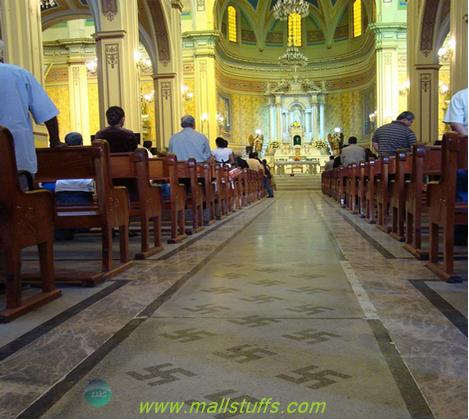
Swastika in Presbyterian Church, Florida
In 1889, the founder of standard oil company constructed Presbyterian Church of St. Augustine, Florida in Venetian Renaissance style. This church is unique and different than other Presbyterian churches across the world. One of its most remarkable and beautiful feature is the pattern of swastikas in Sienna marble tiles. Recently, vandals painted swastika and star of David on Presbyterian Church to humiliate Jews.
Swastika in Theosophical Society
In 1975, Theosophical Society was founded in New York City of America. Because of being a secular organisation Theosophical Society decided to include all religious symbols in its logo. Finally, they came up with a logo with Hinduism most sacred symbol ‘Aum’ at the top and Buddhism Most sacred symbol ‘swastika’ beneath ‘Aum’. Symbol of other ancient religions like the hexagon, Star of David, Ankh and Ouroboros were also added in its logo.

After the world war, all the organization or institutions in western countries using the swastika symbol has been in controversy and under immense pressure to remove the swastika symbol. For some reasons, logo of Theosophical has been free from such controversy, and they still use the same logo. By embedding the symbols of all ancient religions, the logo of the theosophical Society symbolizes profound philosophical and spiritual concepts about the mankind and this universe. Combining all the religious symbols suggest the continuous evolutionary physical, spiritual and natural process of this universe.
Swastika in Pueblo Revival
In 1926, Pueblo Revival also known as Spanish Colonial Revival is decorated with swastika. This monument is situated at orcutt ranch horticulture centre, West hills, Los Angeles. This monument was constructed in Mission Revival architecture and has been designated as a Los Angeles Historic-Cultural Monument.
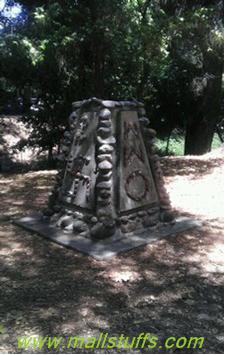
Los angles cultural monument
Swastika removed from Immanuel Presbyterian Church
In Los Angeles, Mueller tiles with swastika inscriptions can be found at the Immanuel Presbyterian Church (built in 1928) and St. James Episcopal Church (built in 1927). In St. Cloud Minnesota, the oldest parish of Christian community, five terracotta tiles were removed in May 2006. The church was originally constructed in 1920 with many swastika embedded decorative tiles and with some ancient form of Christianity cross. During construction, church was under the direct control of the Benedictine Monks at ’Saint Johns University , who arrived from Pennsylvania to Central Minnesota in 1851.
These tiles with swastika designs were known as the Gammadion (hooked cross) and were represented as crux gammata. There was an alternating pair of swastika tiles and related design containing Lauburu or "Basque cross”.
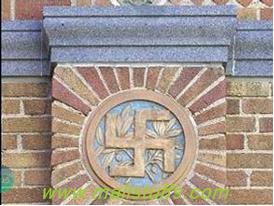
Interesting point to note is that the design of this church was created by local architect named Nairne W. Fisher. Nairne fisher was the soldier who fought against the german during world war. According to the records at Stearns History Museum, approx ten years before the design of St. Mary's was made, more than 200 locals of German origin serving in the United States army fought against German Nazis party. After the victory, president of united states Wilson wrote a letter to the church bishop acknowledging his valuable support during the war.
In spite of this, tiles with swastika designs were removed and destroyed after the consistent criticism from the former faculty of church who displayed a series of articles with manipulative facts like the symbol meant “Aryan conquest and mastery”. Articles made no references to original meaning of swastika, its use since millenniums, instead the articles mentioned statements like “Hilter used Swastika in 1920 and then the architect of the church decided to use this German symbol”. This wrong information was further supported by many small, obscure organizations who wanted to remove the symbol related to Germany Nazist party without recognizing its deep spiritual meaning.
Swastika in Saint Joseph Cathedral
Some other churches with swastika designs included Saint Joseph Cathedral of West Virginia, designed by architect Edward J. Weber of Pittsburgh, in 1925. This building is successor to the original cathedral, constructed in 1847.

Swastika in first Chinese church
In1929, first Chinese church was constructed in Hawaii with beautiful wooden pews containing anti-clockwise swastika carvings. Similar to the Nazi flag, these swastikas are tilted at an angle. According to church officials “Symbol on the wooden pew is an ancient symbol which means complete bliss”. This church was design in an architectural Pattern to include both then ancient Chinese design as well as modern western designs.
Swastika in St. Columbus Church
In Johnstown, Pennsylvania, St. Columbus Church was completed in 1914 for English speaking immigrants. Design of this church was made by Pittsburg architect John T. Cornes. Various forms of swastika designs and holy cross can be found in sanctuary mosaic floors. A local artist said "People must realize the original meaning of swastika and must be aware that swastika is not a sign of horror and hatred; instead, it symbolizes good lock and fortune”
Swastika in grave
Before World War II, many families were using swastika instead of holy cross on graves and coffins. One of such graves can be seen below

Swastika in St. Lawrence Church, Indiana
In March 1966, Swastika floor tiles were removed from the St. Lawrence Church of Lafayette, Indiana. This church was built in the early 1920s. Considering it as a symbol of Nazism, these tiles were removed during renovation of the church entrance.
Swastika removed from town hall, Massachusetts
In 1990, seaside community of Hull, Massachusetts voted to remove swastika tiles from their town hall floor. Built in 1923, Swastika tiles were removed after complaints from the New England Director of the Jewish defense league, in spite of opposition from a local Jewish synagogue.
Swastika in Canada temple
In Canada, swastika symbol can be found at gate of Hong Fa temple

Buddhist Association of Canada & Hong Fa Temple
Swastika in Educational institutions
Before the start of World War II, American students believed swastika to be the symbol of their ancestry and frequently used word or symbol swastika in their work, title of books, clubs etc.
Swastika in University of Michigan
In 1929, student union of University of Michigan included various religious symbols on stained glass windows. Along with the Christian cross, this window included the right arm facing swastika, Hebrew symbol “Star of David”, etc.
Swastika in Yale University
Founded in 1701, the university is the third-oldest institution of higher education in the United States.
Above the entrance of Yale University, there is a small swastika among other elaborate carvings representing several ancient cultural symbols. Further, in 1939, a skeleton on top of swastika was exhibited in Yale university art gallery.
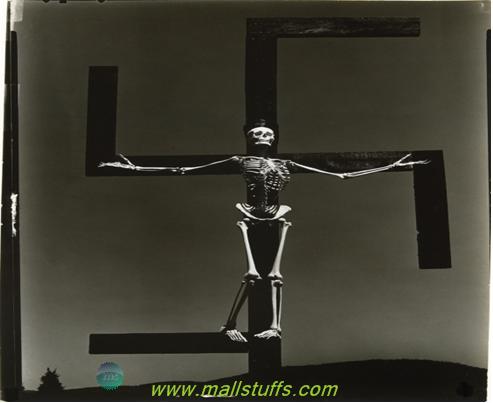
Swastika in Yerkes Observatory
Yerkes Observatory, the "the birthplace of modern astrophysics," is an astronomical observatory operated by the University of Chicago. This observatory has the world's largest refracting telescope used for astronomy and has a collection of over 100,000 photographic plates. In 1897, an ornate decoration at the Yerkes Observatory of Geneva Lake Wisconsin included swastika adjacent to a Star of David, Jews sacred symbol.
Swastika in Harvard University
Harvard University is one of the world’s most famous university with some top entrepreneurs having studied here. It is the oldest institution of higher learning in the United States. Its magnificent history, influence, and wealth made it one of the most prestigious universities in the world
In 1908, Harvard University Library created a leather fob with a brass swastika for presidential campaign of William Jennings Bryan.

Swastika in University of Maine
University of Maine (UMaine or UM) is a public research university established in 1865. This is the largest university of maine state and the only institution to be classified as research university. When viewed from satellite images, three dormitories of this university of swastika shapecan be located.
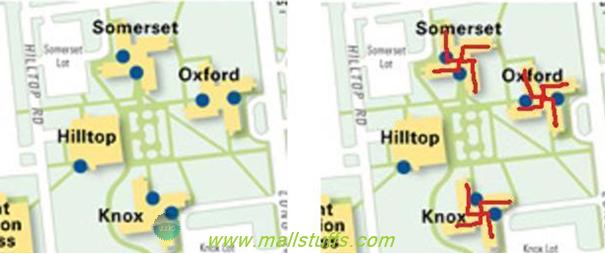
Swastika in William College
In William college of Massachusetts, bricks with left facing tilted swastika can be found at Weston building , which was originally a fraternity with a charter that banned non-Caucasians and Jews. This building was used by students and professors to conduct language classes and for ensuring regular use of other languages and cultures. Behind this building, there is a Jewish religious center. 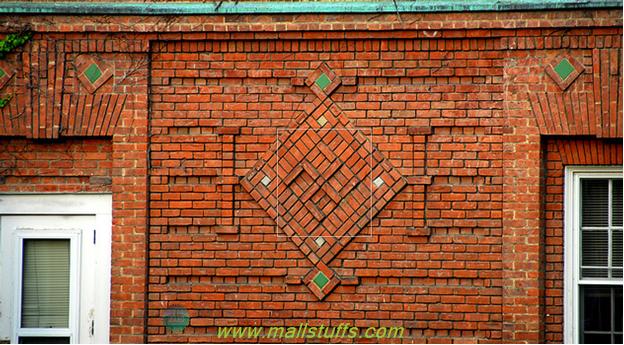
Swastika in Tennessee State University
Founded in 1794, Tennessee State University has eleven graduate colleges and nine undergraduate colleges. It is one of the famous universities where the students from around 100 foreign countries come for their higher studies. The 1939 yearbook of Tennessee State University lists”Swastika Club” among other women’s student organizations. Focused on literature, this group promoted "clear and straight thinking".
Swastika in Catawba College
Founded by United Church of Christ at 1851 in North Carolina, Catawba College is one of the best schools in field of arts and music. In 1927 yearbook of Catawba College , where this book was called as "Swastika", named after a Native American design patterns found in tiles and floors of campus administration building. After swastika became the symbol of Nazis party, this name was changed in 1941.
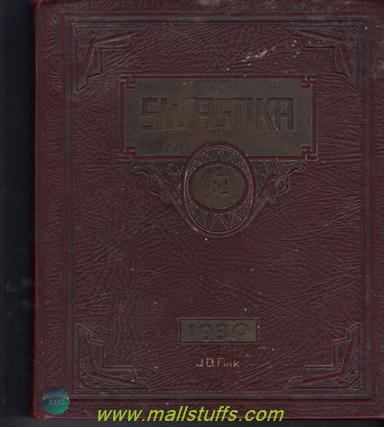
1930 "Swastika" Catawba College Yearbook
Swastika in Wisconsin school
Based at the Madison and constructed at the start of ninetieth century, Wisconsin school played a prominent role in American labor economics. In 1991, voting was done by the Wisconsin school board to remove swastika engraved tiles from their high School physical education building.
Swastika in HPER
Beautiful Native American swastika designs can be found in tiles, walls and stairwells of HPER (Health, Physical Education and Recreation) Building of Indiana University. After the Nazis use of swastika, Complaints were raised by students to remove all such tiles, Responding to such complaints, president of university explained the original meaning of swastika along with its history and the context in which it was placed in HPER building during its construction in 1917, long before the use of symbol by the Nazis. The student appreciated &applauded the response thereby giving up their demand of removing the swastika tiles.

Swastika in Gettysburg College
Founded in 1832, Gettysburg College is a private art college founded in 1832, in Gettysburg, Pennsylvania , United States, adjacent to the famous battlefield. Built completely in 1927, floor tiles with swastika designs were used at Gettysburg College of Pennsylvania .
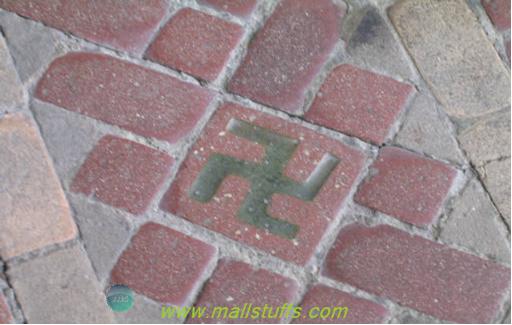
Swastika in Gansevoort Elementary School
In November 1998, Sentinel newspaper of New York reported the case of swastika tiles destruction at the Gansevoort Elementary School. According to newspaper report, these tiles were placed on floors of this school 84 years ago at 1914. In a grieving tone, newspaper editor said "School officials lost a chance to enlighten the public. A recommendation earlier this year by a committee of Gansevoort staff and parents to "leave the floor as is" and install a display about the history of the swastika was ignored. Instead, at the risk of being viewed by a small, uninformed segment of the community as being politically incorrect , they knuckled under to pressure rather than educate. How unfortunate!"
In its report, sentinel newspaper added that similar tiles were left untouched at a nearby Jewish synagogue of Utica, New York ”because the connotation to the Jewish congregation is not that of the Third Reich."
Similar incident became the subject of controversy in White Plains; New York where the Swastika tiles of a condominium lobby of local housing complex was condemned at television and internet posting in September 2011. Instead of bowing down to the complaints, housing complex management explained the fact and said he ties was placed in the complex in 1924, long before the world war ll, noting it had never received a complaint before."
Swastika in Central High School Colorado
Right facing swastika can be found on tiles and floors of Central High School in Pueblo, Colorado. Built in 1906, this school was added to the National Register of Historic Places in 1979.
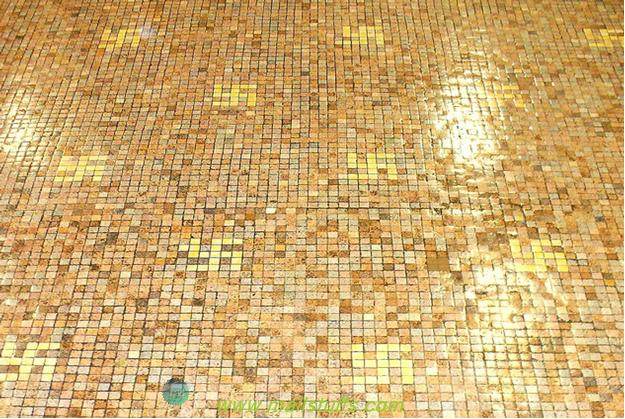
Swastika in A.K. Smiley public library, Colorado
Similarly, National Register of Historic Places added a California public library called A.K. Smiley Public Library. Built in 1894, this library with swastika engraved tiles became a California State Historic Landmark in 1990.
Swastika in Minneapolis Institute of Art
The Minneapolis Institute of Arts (MIA) is a fine art museum situated in the Whittier neighborhood of Minneapolis. In spite of much controversy surrounding swastika symbol, the Minneapolis Institute of Arts decided to use candlestick with swastika motif in the festive season of Christmas of year 2007. Interior design of this room was created by a Minneapolis architect and has been preserved since 1905. These symbols as seen in the Duluth Room have no Third Reich connotations, but rather refer to the ancient symbol."
According to ADL, "Prior to the Nazis co-opting this symbol, it was known as a good luck symbol and was used by various religious groups. Hitler made the Nazi swastika unique to his party by reversing the normal direction of the symbol so that it appeared to spin clockwise." Using the definition the ADL, law enforcement agencies classifies some of the historic tiles found in ancient colleges, university and religious institutions as extremist symbols because in this ancient symbol, arms are twisted as shown in Nazis flags contradictory to the untwisted arms of original swastika symbol.

Original untwisted Swastika and Aum symbol
So, regardless of the date of origin, many historic tiles and floorings having swastika designs were removed from old buildings, colleges and institutions of America.
Swastika may be offensive to many western religions but if you come to the eastern side of the world than you will find this symbol auspicious in almost all Asian countries. With more than one billion Hindus, Jains and Buddhists still regarding swastika as auspicious, it should hardly be perceived as “one of the most hated symbols in human history.”